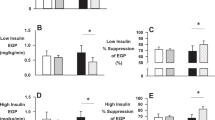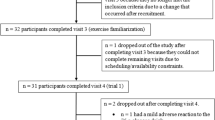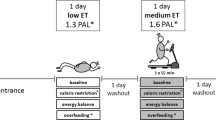Abstract
Objective:
Short-term exercise training improves glycemic control, but the effect of short-term training on postprandial satiety peptide responses or perceived satiety remains unknown. We tested the hypothesis that short-term aerobic exercise training (15 days) would alter postprandial pancreatic and gut peptide (pancreatic polypeptide (PP) and peptide YY (PYY)) responses and perceived appetite and satiety in obese individuals.
Subjects:
Thirteen healthy obese men and women (age: 42±2 years; body mass index: 30–45 kg m−2).
Measurements:
Subjects were studied before and after 15 days of training (walking 1 h at 70–75% VO2peak). On the study day, subjects consumed 1500 kcal as six meals (250 kcal: 9 g protein, 40 g carbohydrate, 6 g fat), while blood samples and satiety measurements were taken at baseline and every 20 min for 12 h. Blood was analyzed for PP, PYY, glucose and insulin levels. Appetite and satiety was assessed with a visual analog scale throughout the day.
Results:
Incremental area under the curve (iAUC) for PP increased significantly with training (pre: 2788±753; post: 3845±830 pg ml−1·per min for 12 h; P<0.001), but there was no difference in the PP response to each meal. The initial PP response to the first meal increased (ΔPPmin 20–0: pre 86±25; post 140±36 pg ml−1; P<0.05) with training. PYY iAUC showed no significant changes with training but showed a significant main effect of time across meals, with the largest response being to the first meal (P<0.005). There were no changes in satiety, glucose or insulin levels with training.
Conclusion:
Short-term exercise training increases postprandial PP concentrations in obese individuals; however, PYY levels and glycemic control remain unaffected. Both PP and PYY show meal-induced increases at all meals, but PYY has a greater response at the first meal with reduced responses at subsequent meals.
This is a preview of subscription content, access via your institution
Access options
Subscribe to this journal
Receive 12 print issues and online access
$259.00 per year
only $21.58 per issue
Buy this article
- Purchase on Springer Link
- Instant access to full article PDF
Prices may be subject to local taxes which are calculated during checkout



Similar content being viewed by others
References
Maier C, Riedl M, Vila G, Nowotny P, Wolzt M, Clodi M et al. Cholinergic regulation of ghrelin and peptide YY release may be impaired in obesity. Diabetes 2008; 57: 2332–2340.
Wren AM, Bloom SR . Gut hormones and appetite control. Gastroenterology 2007; 132: 2116–2130.
Kojima S, Ueno N, Asakawa A, Sagiyama K, Naruo T, Mizuno S et al. A role for pancreatic polypeptide in feeding and body weight regulation. Peptides 2007; 28: 459–463.
Zipf WB, O’Dorisio TM, Cataland S, Sotos J . Blunted pancreatic polypeptide responses in children with obesity of Prader–Willi syndrome. J Clin Endocrinol Metab 1981; 52: 1264–1266.
Berntson GG, Zipf WB, O’Dorisio TM, Hoffman JA, Chance RE . Pancreatic polypeptide infusions reduce food intake in Prader–Willi syndrome. Peptides 1993; 14: 497–503.
Gingerich RL, Hickson RC, Hagberg JM, Winder WW . Effect of endurance exercise training on plasma pancreatic polypeptide concentration during exercise. Metabolism 1979; 28: 1179–1182.
Li JB, Asakawa A, Li Y, Cheng K, Inui A . Effects of exercise on the levels of peptide YY and ghrelin. Exp Clin Endocrinol Diabet 2011; 119: 163–166.
Adrian TE, Ferri GL, Bacarese-Hamilton AJ, Fuessl HS, Polak JM, Bloom SR . Human distribution and release of a putative new gut hormone, peptide YY. Gastroenterology 1985; 89: 1070–1077.
Ashby D, Bloom SR . Recent progress in PYY research—an update report for 8th NPY meeting. Peptides 2007; 28: 198–202.
Alderdice JT, Dinsmore WW, Buchanan KD, Adams C . Gastrointestinal hormones in anorexia nervosa. J Psychiatric Res 1985; 19: 207–213.
Batterham RL, Cohen MA, Ellis SM, Le Roux CW, Withers DJ, Frost GS et al. Inhibition of food intake in obese subjects by peptide YY3-36. N Engl J Med 2003; 349: 941–948.
Batterham RL, Le Roux CW, Cohen MA, Park AJ, Ellis SM, Patterson M et al. Pancreatic polypeptide reduces appetite and food intake in humans. J Clin Endocrinol Metab 2003; 88: 3989–3992.
Degen L, Oesch S, Casanova M, Graf S, Ketterer S, Drewe J et al. Effect of peptide YY3-36 on food intake in humans. Gastroenterology 2005; 129: 1430–1436.
Tschop M, Castaneda TR, Joost HG, Thone-Reineke C, Ortmann S, Klaus S et al. Physiology: does gut hormone PYY3-36 decrease food intake in rodents? Nature 2004; 430: 1.
Martins C, Morgan LM, Bloom SR, Robertson MD . Effects of exercise on gut peptides, energy intake and appetite. J Endocrinol 2007; 193: 251–258.
Ueda SY, Yoshikawa T, Katsura Y, Usui T, Nakao H, Fujimoto S . Changes in gut hormone levels and negative energy balance during aerobic exercise in obese young males. J Endocrinol 2009; 201: 151–159.
Broom DR, Batterham RL, King JA, Stensel DJ . Influence of resistance and aerobic exercise on hunger, circulating levels of acylated ghrelin, and peptide YY in healthy males. Am J Physiol Regul Integr Comp Physiol 2009; 296: R29–R35.
Hagobian TA, Sharoff CG, Stephens BR, Wade GN, Silva JE, Chipkin SR et al. Effects of exercise on energy-regulating hormones and appetite in men and women. Am J Physiol Regul Integr Comp Physiol 2009; 296: R233–R242.
Guelfi KJ, Donges CE, Duffield R . Beneficial effects of 12 weeks of aerobic compared with resistance exercise training on perceived appetite in previously sedentary overweight and obese men. Metabolism 2012; 62: 235–243.
Gueugnon C, Mougin F, Nguyen NU, Bouhaddi M, Nicolet-Guénat M, Dumoulin G . Ghrelin and PYY levels in adolescents with severe obesity: effects of weight loss induced by long-term exercise training and modified food habits. Eur J Appl Physiol 2012; 12: 1797–1805.
Kelly KR, Brooks LM, Solomon TP, Kashyap SR, O’Leary VB, Kirwan JP . The glucose-dependent insulinotropic polypeptide and glucose-stimulated insulin response to exercise training and diet in obesity. Am J Physiol Endocrinol Metab 2009; 296: E1269–E1274.
Martins C, Kulseng B, King NA, Holst JJ, Blundell JE . The effects of exercise-induced weight loss on appetite-related peptides and motivation to eat. J Clin Endocrinol Metab 2010; 95: 1609–1616.
Gueugnon C, Mougin F, Nguyen NU, Bouhaddi M, Nicolet-Guenat M, Dumoulin G . Ghrelin and PYY levels in adolescents with severe obesity: effects of weight loss induced by long-term exercise training and modified food habits. Eur J Appl Physiol 2012; 112: 1797–1805.
Jenkins DJ, Wolever TM, Buckley G, Lam KY, Giudici S, Kalmusky J et al. Low-glycemic-index starchy foods in the diabetic diet. Am J Clin Nutr 1988; 48: 248–254.
Jovanovic A, Gerrard J, Taylor R . The second-meal phenomenon in type 2 diabetes. Diabetes Care 2009; 32: 1199–1201.
TMS Wolever, Jenkins DJA, Vuksan V, Jenkins AL, Bucklen GC, Wong GS . Beneficial effect of a low glycemic index diet in type II diabetes. Diabetic Med 1992; 9: 451–458.
Johns CE, Newton JL, Westley BR, May FE . Human pancreatic polypeptide has a marked diurnal rhythm that is affected by ageing and is associated with the gastric TFF2 circadian rhythm. Peptides 2006; 27: 1341–1348.
Hill BR, De Souza MJ, Williams NI . Characterization of the diurnal rhythm of peptide YY and its association with energy balance parameters in normal-weight premenopausal women. Am J Physiol Endocrinol Metab 2011; 301: E409–E415.
Battaglia GM, Zheng D, Hickner RC, Houmard JA . Effect of exercise training on metabolic flexibility in response to a high-fat diet in obese individuals. Am J Physiol Endocrinol Metab 2012; 303: E1440–E1445.
Black SE, Mitchell E, Freedson PS, Chipkin SR, Braun B . Improved insulin action following short-term exercise training: role of energy and carbohydrate balance. J Appl Physiol 2005; 99: 2285–2293.
Houmard JA, Cox JH, MacLean PS, Barakat HA . Effect of short-term exercise training on leptin and insulin action. Metabolism 2000; 49: 858–861.
Houmard JA, Hickey MS, Tyndall GL, Gavigan KE, Dohm GL . Seven days of exercise increase GLUT-4 protein content in human skeletal muscle. J Appl Physiol 1995; 79: 1936–1938.
McArdle WD, Katch FI, Katch VL . Exercise Physiology: Energy, Nutrition, and Human Performance 4th edn Williams & Wilkins: Philadelphia, 2001.
Heden TD, Liu Y, Sims LJ, Whaley-Connell AT, Chockalingam A, Dellsperger KC et al. Meal frequency differentially alters postprandial triacylglycerol and insulin concentrations in obese women. Obesity (Silver Spring, MD) 2013; 21: 123–129.
Balaguera-Cortes L, Wallman KE, Fairchild TJ, Guelfi KJ . Energy intake and appetite-related hormones following acute aerobic and resistance exercise. Appl Physiol Nutr Metab 2011; 36: 958–966.
Kahleova H, Mari A, Nofrate V, Matoulek M, Kazdova L, Hill M et al. Improvement in beta-cell function after diet-induced weight loss is associated with decrease in pancreatic polypeptide in subjects with type 2 diabetes. J Diabet Comp 2012; 26: 442–449.
Whitcomb DC, Puccio AM, Vigna SR, Taylor IL, Hoffman GE . Distribution of pancreatic polypeptide receptors in the rat brain. Brain Res 1997; 760: 137–149.
Simpson K, Parker J, Plumer J, Bloom S . CCK, PYY and PP: the control of energy balance. Handbook Exp Pharmacol 2012; 209: 209–230.
Jones TE, Basilio JL, Brophy PM, McCammon MR, Hickner RC . Long-term exercise training in overweight adolescents improves plasma peptide YY and resistin. Obesity (Silver Spring, MD) 2009; 17: 1189–1195.
Speechly DP, Buffenstein R . Greater appetite control associated with an increased frequency of eating in lean males. Appetite 1999; 33: 285–297.
Speechly DP, Rogers GG, Buffenstein R . Acute appetite reduction associated with an increased frequency of eating in obese males. Int J Obes Relat Metab Disord 1999; 23: 1151–1159.
Asakawa A, Inui A, Yuzuriha H, Ueno N, Katsuura G, Fujimiya M et al. Characterization of the effects of pancreatic polypeptide in the regulation of energy balance. Gastroenterology 2003; 124: 1325–1336.
Acknowledgements
This study was supported, in part, by an NIH R21DK084467-01 grant. We thank the nurses of the Clinical Research Unit for helping with catheter insertion and monitoring the subjects.
Author information
Authors and Affiliations
Corresponding author
Ethics declarations
Competing interests
The authors declare no conflict of interest.
Rights and permissions
About this article
Cite this article
Kanaley, J., Heden, T., Liu, Y. et al. Short-term aerobic exercise training increases postprandial pancreatic polypeptide but not peptide YY concentrations in obese individuals. Int J Obes 38, 266–271 (2014). https://doi.org/10.1038/ijo.2013.84
Received:
Revised:
Accepted:
Published:
Issue Date:
DOI: https://doi.org/10.1038/ijo.2013.84
Keywords
This article is cited by
-
Exercise, adipokines and pediatric obesity: a meta-analysis of randomized controlled trials
International Journal of Obesity (2017)
-
The gut sensor as regulator of body weight
Endocrine (2015)



